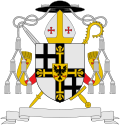
Back Велик магистър на Тевтонския орден Bulgarian Gran Mestre de l'Orde Teutònic Catalan Hochmeister German Gran maestre de la Orden Teutónica Spanish Saksa ordu kõrgmeister Estonian Grand maître de l'ordre Teutonique French Veliki meštar Teutonskog reda Croatian Pemimpin Umum Ordo Teutonik ID Gran maestro dell'Ordine teutonico Italian ドイツ騎士団総長 Japanese
| Grand Master of the Teutonic Order | |
|---|---|
| Hochmeister des Deutschen Ordens | |
 Coat of arms of a Grand Master | |
since 22 August 2018 | |
| Reports to | Holy See |
| Seat |
|
| Term length | six years |
| Formation | 1198 |
| First holder | Heinrich Walpot von Bassenheim |
The grand master of the Teutonic Order (German: Hochmeister des Deutschen Ordens; Latin: Magister generalis Ordo Teutonicus) is the supreme head of the Teutonic Order. It is equivalent to the grand master of other military orders and the superior general in non-military Roman Catholic religious orders. Hochmeister, literally "high master", is only used in reference to the Teutonic Order, as Großmeister ("grand master") is used in German to refer to the leaders of other orders of knighthood.
An early version of the full title in Latin was Magister Hospitalis Sanctae Mariae Alemannorum Hierosolymitani. Since 1216, the full title Magister Hospitalis Domus Sanctae Mariae Teutonicorum Hierosolymitani ("Master of the Hospital House of the Blessed Virgin Mary of the Germans of Jerusalem") was used.
The offices of Hochmeister and Deutschmeister (Magister Germaniae) were united in 1525. The title of Magister Germaniae had been introduced in 1219 as the head of the bailiwicks in the Holy Roman Empire, from 1381 also those in Italy, raised to the rank of a prince of the Holy Roman Empire in 1494, but merged with the office of grand master under Walter von Cronberg in 1525, from which time the head of the order had the title of Hoch- und Deutschmeister.[1] From 1466 to 1525, the Grand Masters of the Teutonic Order were vassals and princes of the Polish Crown.[2]
- ^ "Bernhard Peter (2011)". Archived from the original on 2015-09-23. Retrieved 2015-02-28.
- ^ Górski, Karol (1949). Związek Pruski i poddanie się Prus Polsce: zbiór tekstów źródłowych (in Polish and Latin). Poznań: Instytut Zachodni. pp. 96–97, 103, 214–215, 221.

